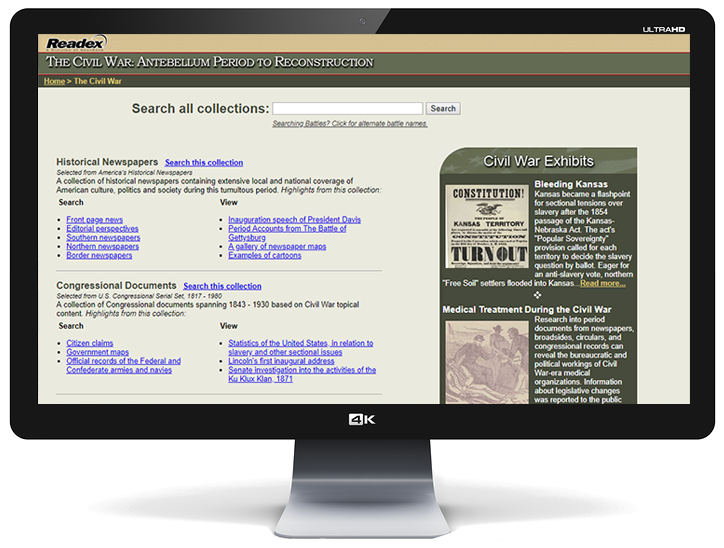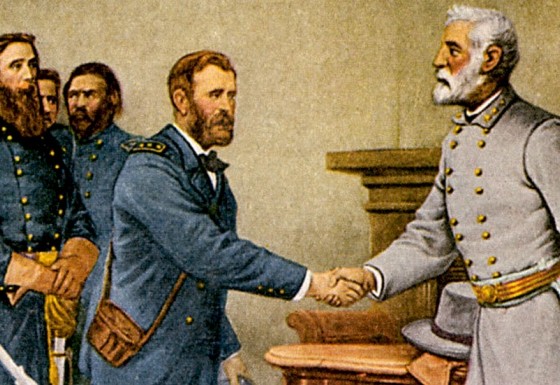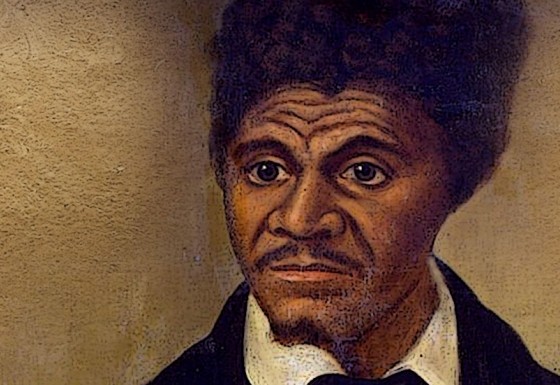
The Civil War
Antebellum Period to Reconstruction
- More than 150 newspapers, including major titles from every region of the U.S.
- Approximately 50,000 government documents and 4,000 rare broadsides and pieces of ephemera
- Extensive local and national coverage of American culture, politics and society during this tumultuous period
For researching and teaching the most important event in 19th-century American history, Readex offers The Civil War: Antebellum Period to Reconstruction. This unique resource features more than 150 newspapers from all regions of the United States—plus approximately 50,000 government documents and 4,000 rare broadsides and pieces of ephemera. Together, this diverse collection of primary materials provides unprecedented local and national coverage of American culture, politics and society from 1840 through 1877—a tumultuous time that redefined a nation.
From newspapers to government publications to broadsides and ephemera
The newspapers in The Civil War include the Baltimore Sun, Charleston Mercury, Dallas Weekly Herald, Milwaukee Sentinel, National Intelligencer, New Orleans Picayune, New York Herald, New York Tribune, Philadelphia Inquirer, San Francisco Bulletin and more than 140 others. Featuring many titles of unique historical significance, this extensive selection of newspapers provides not only detailed news stories and illustrations, varied editorial views and illuminating advertisements, but also eyewitness military reporting by the nation’s best journalists.
Essential resources published by the U.S. government include “The War of the Rebellion: A Compilation of the Official Records of the Union and Confederate Armies,” “Journal of the Congress of the Confederate States of America” and many others.
Rich with illustrations, the broadsides and ephemera include song sheets, poems, envelopes and other hard-to-find printed materials that shed new light on the Civil War era. These infrequently used documents—often no more than a single page—illuminate the daily struggles of not only the soldiers, but also the families they left behind.
Wide-ranging primary sources in one online resource
The Civil War: Antebellum Period to Reconstruction contains primary source materials selected from the acclaimed Archive of Americana. Researchers will be able to search subsets of America’s Historical Newspapers, American Broadsides and Ephemera and the U.S. Congressional Serial Set. The text of newspapers, broadsides and government documents—digitized from the holdings of the American Antiquarian Society, Dartmouth College Library, the Library of Congress and other renowned institutions—may also be cross-searched in one easy step.
Valuable coverage from newspapers, government documents and broadsides
Explore 100 years of published works on slavery and abolition
“Extraordinarily useful....the ability swiftly to locate these stories...proved invaluable.”
— J. Michael Rhyne, Associate Professor, College of Arts and Sciences, Urbana University
Challenge

History students at Urbana University, a small university in west central Ohio specializing in liberal arts education, were given the task of gathering information about the Underground Railroad in Ohio. The students focused on the story of Addison White and the event that took place in the tiny neighboring town of Mechanicsburg—an event that would lead to a federal court case to determine the constitutionality of the Fugitive Slave Act.
According to Julie Ann McDaniel, a librarian at Urbana University’s Swedenborg Memorial Library, many local students knew vaguely of the story of White, a runaway slave from Kentucky, but did not know enough specifics to craft an account of what happened nearby in 1857.
Solution
Using The Civil War: Antebellum Period to Reconstruction, an online resource, the students were able to trace reports of and reaction to the story and court case from newspapers throughout the United States. What started as a local event—the townspeople of Mechanicsburg arriving with pitchforks and carpet beaters to chase the slave catchers away that were sent to bring White back to his master—soon became a nationwide story.
“Our students were able to see how details were distorted, overlooked and misreported,” said McDaniel. “They were able to see how differing opinions tinged the reporting about the case.”
As a result of the research the history students did using the database, theatre students and faculty were able to create a Readers Theatre piece titled “Law and Disorder” that was shared with more than 150 people from the campus and community. Students read text from newspapers to recreate the events, and involved the audience by asking them to vote which newspaper reports represented their views.
Urbana history professor J. Michael Rhyne, Ph.D, said the database allowed his students to put the Addison White case in national perspective, coinciding as it did with the Supreme Court’s ruling on the Dred Scott case. “We found that readers throughout the nation received detailed accounts in their newspapers of events in and around what we had assumed to be the sleepy little hamlet of Mechanicsburg, Ohio,” he said.
Ultimately, the information provided by The Civil War: Antebellum Period to Reconstruction enabled students to conduct primary source research without extensive travel or time delays waiting for microfilm reels to arrive through interlibrary loan. “It allowed our students to see a historical event reveal itself as they moved from one report to the next,” noted McDaniel. “And by using the Readers Theatre format to share the story of Addison White, they demonstrated their learning and understanding of the complex case in a unique way.”

About the Institution
Urbana University was founded in 1850. With an enrollment of nearly 1,500 students, it is small enough to foster close connections between faculty and students, but large enough to provide cutting-edge programs that will help students build the skills necessary to succeed in the career path of their choice.
About the Product
The Civil War: Antebellum Period to Reconstruction—a winner of Choice’s 2010 Outstanding Academic Title award—contains primary source materials selected from the acclaimed Archive of Americana. Researchers are able to search relevant subsets of America’s Historical Newspapers, American Broadsides and Ephemera and the U.S. Congressional Serial Set.
Stay in Touch
Receive product news, special offers and invitations, or the acclaimed Readex Report
Sign UpBy clicking "Sign Up", you acknowledge that you have read and understand our Privacy Policy and Terms of Use.





